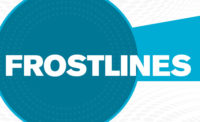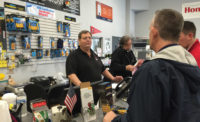HARDI noted that all regions showed positive median numbers, with the highest median coming from the Southeastern region with an increase of 17.63 percent and the lowest reported median from the Northeastern region at 6.27 percent. Bud Healy, director of education, HARDI, believes the positive trend will continue, noting, "We probably won't have a double digit increase in 2006, but our forecast is saying about 7.5 percent."
Even though things look rosy, distributors are still feeling the effects of the transition to 13 SEER. Lingering issues such as product availability, pricing, and warehouse space are still being worked out in many cases, and distributors have concerns over where these issues will ultimately leave them.

REASONS FOR GROWTH
As everyone knows, the HVAC business is seasonal in nature, and the industry benefits if both summer and winter come early and stay for a long time. The record temperatures last summer helped distributors move large amounts of equipment all across the country. That, combined with selling record numbers of 10 to 12 SEER equipment, helped the distribution industry have a profitable year."We had a very hot summer, which was helpful," said Don Frendberg, executive vice president/COO, HARDI. "As we've always said, we make money when people are miserable. If we get an early summer in April, then customers decide they're not going to go through the summer with an old air conditioner."
David Williams, vice president/owner, Gateway Supply, which has locations throughout South Carolina, agreed, noting, "We had an extremely long and hot summer, which extended all the way through October. We were able to move more equipment in 2005 than ever before."
Williams stated that his company had its largest sales year ever, with a growth rate of over 20 percent. While he acknowledged the steamy summer as being very helpful in achieving the record sales, he was also quick to attribute the growth to his loyal customers, as well as his quality personnel.
Weather is also an issue for our friends to the north. Tom Boutette, president, Boutette & Barnett, London, Ontario, noted, "We have a very short window of opportunity, so a cold summer can affect air conditioning sales." Although Boutette reported that sales at his company grew substantially in 2005.
Boutette expects to grow his business significantly in 2006 as well, as the company is opening a new 25,000-square-foot distribution center in the Toronto area. "The challenge will be to grow in a controlled manner, maintain our high level of customer service, keep employees motivated, and maintain a solid operating system," he said.

LINGERING CONCERNS
Williams is hoping that he will have as much success in 2006 as he had in 2005, however, he is still concerned about the transition to 13 SEER. "Product availability of the new equipment is a huge factor in our potential success this year," he said. "Of course, there will be a struggle if we don't receive the product to sell, and unfortunately, the availability is out of our control. We must trust our manufacturer to provide us with complete product offerings in a timely manner."The reason for the delay in receiving product is often due to the fact that the 13 SEER transition required a major tooling change for manufacturers. While Frendberg has not heard that many distributors are having problems obtaining equipment, there have been hiccups here and there that have made the transition less than smooth in some cases.
"There's always a period of time before the flow of product levels out," said Frendberg. "In most cases, that flow depends on how well the manufacturer or the distributor guessed how the transition would go. Those who guessed well are doing the best at this point."
Williams noted that distributors like to control their inventory levels to best serve their customers. "With the transition to 13 SEER, our inventories levels have basically been dictated to us. We have missed numerous sales opportunities because the product was just not available. It completely goes against our nature when we are unable to help solve a customer's need."
Much of Williams' inventory of 10 and 12 SEER equipment is already committed to ongoing projects, while the balance of inventory is going quickly. The reason for that is the price difference between the lower SEER and the 13 SEER equipment is significant enough that many are opting for the less expensive units.
Boutette anticipates selling out of 10 and 12 SEER equipment early in the season as well for the same reason: cost. "Pricing will be an issue as long as there is product available," he noted.
Fluctuations in pricing are likely to continue for 13 SEER equipment, primarily due to the spike in oil, steel, copper, and aluminum costs. As Frendberg noted, "It's difficult for distributors to stay on top of price changes and convince their customers that they're relevant. It's always a major issue."
Another issue facing distributors is the increased size of the 13 SEER equipment. Williams noted that the storage and handling of the significantly larger equipment is stretching the limitations of many of his warehouses. "We are in the process of expanding to accommodate the new equipment."

WHAT'S NEXT
While still working on smoothing out the bumps from the transition to 13 SEER, distributors are looking ahead to the next big issue, which is the elimination of R-22 units in 2010. Chances are this will cause many challenges for the distributor as well."Not only do we have to help the dealers make the transition to R-410A, we will also have to support the R-22 units for many years beyond 2010," said Williams. "With the refrigerant change, many common parts will not work from one unit to the other as they do today. This will require larger and larger parts inventory levels for our branches."
Boutette expects the R-410A market will grow significantly this year, while Williams remarked that his company is stocking more R-410A product than it ever has before. "The R-22 deadline is just around the corner," said Williams. "In my opinion, dealers should recognize that if they sell their customers R-22 all the way up to 2010, they will be doing their customers a disservice."
Indoor air quality (IAQ) is another area that continues to grow for distributors, mainly due to the fact that over the last several years the HVAC industry has been moving away from just heating and cooling spaces to providing more indoor comfort.
"I believe our industry will become more and more focused on customer comfort, with a significant increase in IAQ products," said Williams. "As distributors, we must keep up with all the new products and be well versed in their benefits."
Being on top of the issues and very familiar with all the new products - along with another hot summer - will go a long way in helping distributors have another successful year in 2006.
Publication date: 03/13/2006



